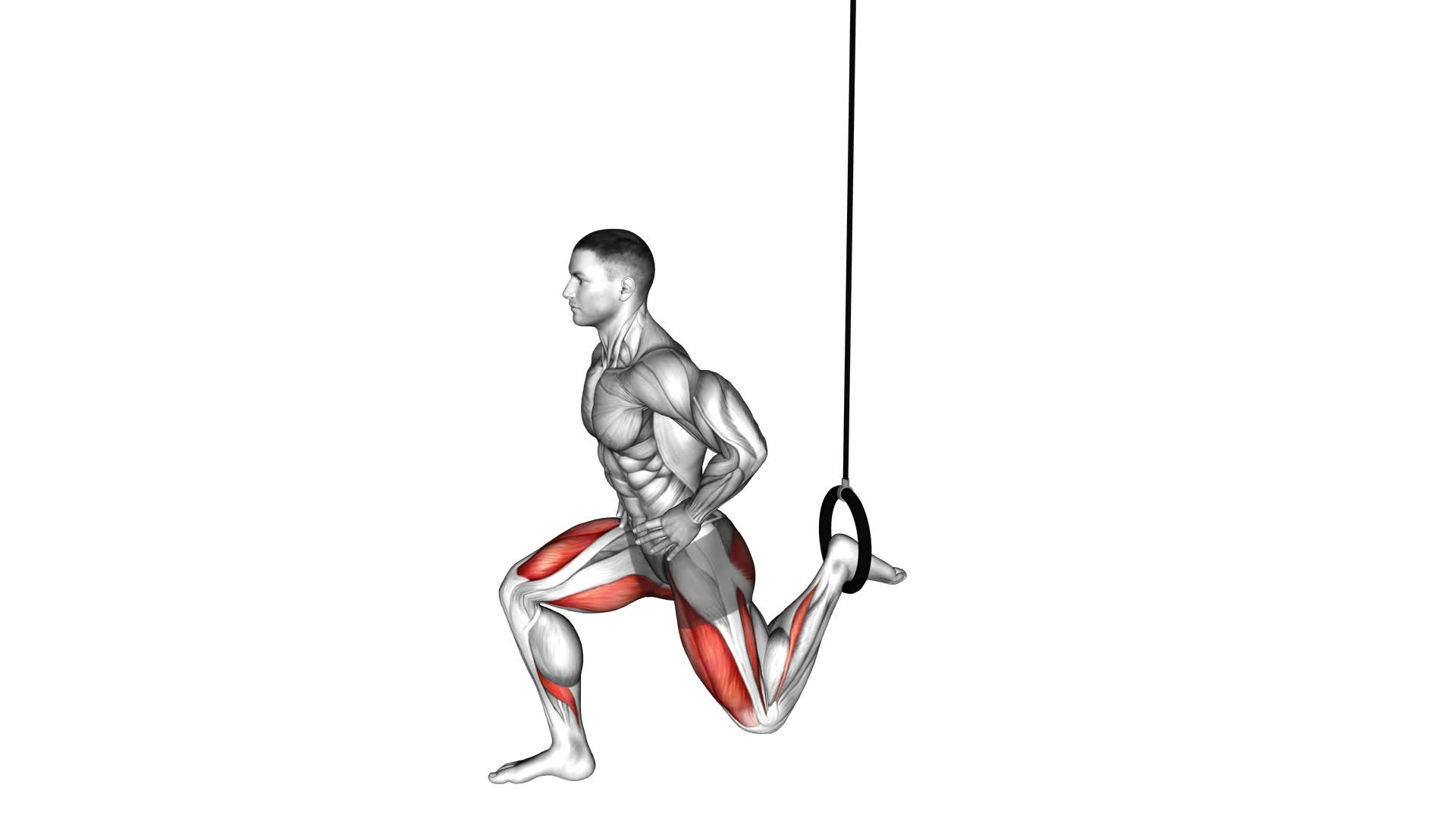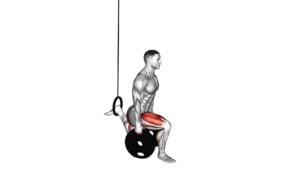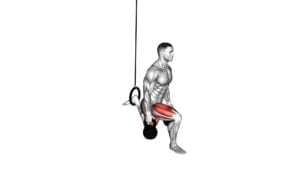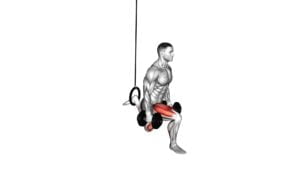Ring Split Squat – Video Exercise Guide & Tips

Get ready to take your lower body workout to the next level with the Ring Split Squat. In this video exercise guide, we'll show you the proper form and technique to maximize the effectiveness of this challenging exercise.
Watch This Exercise Video
Discover the benefits, variations, and common mistakes to avoid, all designed to help you achieve your fitness goals.
So grab your rings and get ready to strengthen and tone your legs like never before.
Let's dive in!
Key Takeaways
- Improved lower body strength and stability
- Targets quadriceps, hamstrings, glutes, and calves
- Engages core muscles for enhanced stability and balance
- Versatile exercise that can be modified based on fitness level
Benefits of the Ring Split Squat
The benefits of the Ring Split Squat include improved lower body strength and stability. This exercise is a variation of the traditional split squat, where you use rings for added instability and a greater challenge. The ring split squat primarily targets the quadriceps, hamstrings, glutes, and calves, making it an excellent exercise for developing leg muscles. Additionally, the instability created by the rings engages your core muscles, enhancing overall stability and balance.
One of the main advantages of the ring split squat is its versatility and ability to be modified based on your fitness level. If you're a beginner, you can use the rings for support, providing assistance during the movement. As you progress, you can gradually decrease the assistance and eventually perform the exercise without any support. This modification allows you to gradually increase the difficulty and intensity of the exercise, ensuring continuous progress and muscle development.
Proper Form and Technique for the Ring Split Squat
To perform the ring split squat with proper form and technique, you should start by positioning yourself in a lunge stance. Here's a step-by-step guide to help you nail the proper form:
- Begin by standing with your feet hip-width apart and the rings hanging at a comfortable height.
- Take a step forward with one foot, keeping your knee directly above your ankle and your back leg straight.
- Lower your body until your front thigh is parallel to the ground, ensuring that your back knee hovers just above the floor.
- Push through your front heel to return to the starting position.
- Repeat the movement for the desired number of repetitions before switching to the other leg.
When performing the ring split squat, it's important to engage the right muscles. This exercise primarily targets the quadriceps, glutes, and hamstrings, helping to strengthen and tone your lower body. To make the exercise more challenging, you can try adding weight or elevating your front foot on a step or platform. Conversely, if you're looking for a modification, you can perform the split squat without the rings or use a support to assist with balance.
Remember to maintain proper form throughout the movement, keeping your core engaged and your chest lifted. By following these tips, you'll be able to perform the ring split squat with proper form and technique, maximizing its benefits for your lower body muscles.
Variations and Progressions of the Ring Split Squat
To further challenge yourself and continue progressing with the ring split squat, you can explore different variations and modifications.
One modification you can try is the elevated ring split squat. Place your rear foot on a stable elevated surface, such as a step or a box, while keeping the front foot on the ground. This variation increases the range of motion and adds an extra challenge to your lower body muscles.
Another modification is the weighted ring split squat. Hold a dumbbell or kettlebell in one hand and perform the split squat while holding the weight. This variation increases the resistance and helps to build strength in your legs.
For advanced ring split squat variations, you can try the Bulgarian split squat with rings. Instead of using a stable surface, place your rear foot in a ring. This challenges your balance and stability even more, engaging your core muscles as well.
To further intensify the exercise, you can incorporate plyometric movements into the ring split squat. Perform explosive jumps while switching legs in mid-air, landing with the opposite leg forward. This variation increases power and adds a cardiovascular component to the exercise.
By exploring these ring split squat modifications and advanced variations, you can continue challenging your lower body muscles and progressing in your fitness journey.
Now, let's move on to the next section and discuss common mistakes to avoid while performing the ring split squat.
Common Mistakes to Avoid While Performing the Ring Split Squat
When performing the ring split squat, be mindful of common mistakes to avoid. To ensure proper form and maximize the effectiveness of the exercise, here are some important points to keep in mind:
- Common errors in ring split squat technique:
- Leaning too far forward: It's crucial to maintain an upright torso throughout the movement. Leaning forward can put excessive strain on the knees and compromise stability.
- Inadequate depth: Going too shallow in the squat limits the activation of the glutes and hamstrings. Make sure to lower your body until the front thigh is parallel to the ground.
- Unstable foot positioning: Proper foot placement is essential for balance and stability. Ensure that your front foot is flat on the ground and your back foot is on the toes, with the heel pointing upward.
- Modifications for individuals with limited mobility in ring split squat:
- Use a bench or elevated surface: If you struggle with balance or flexibility, placing your back foot on a bench or elevated surface can provide support and allow you to perform the exercise with greater ease.
- Decrease range of motion: If you have limited mobility in your hips or knees, you can reduce the depth of the squat. This modification still allows you to engage your leg muscles while working within your range of motion.
- Start with bodyweight only: If you're new to the ring split squat or have significant mobility limitations, it's best to begin with bodyweight only. This will allow you to focus on mastering the movement pattern before adding additional resistance.
Tips for Maximizing the Effectiveness of the Ring Split Squat
To maximize the effectiveness of the ring split squat, focus on maintaining proper form and engaging the targeted muscles throughout the exercise. Here are some tips to help you get the most out of this exercise.
Firstly, consider incorporating ring split squat modifications to challenge your muscles in different ways. For example, you can try elevating your front foot on a step or box to increase the range of motion and place more emphasis on your glutes and quadriceps. Alternatively, you can perform the exercise with a weighted vest or dumbbells to add resistance and further strengthen your lower body.
Secondly, pay attention to ring split squat muscle activation. Make sure to engage your quadriceps, hamstrings, and glutes throughout the movement. Focus on pushing through your front heel to activate the quadriceps and glutes, and maintain tension in your hamstrings by keeping your back leg straight and extended.
Finally, remember to breathe properly during the exercise. Inhale as you lower your body down and exhale as you push up to maintain core stability and provide your muscles with the oxygen they need for optimal performance.
Frequently Asked Questions
How Many Calories Does the Ring Split Squat Burn?
The ring split squat is a challenging exercise that can help you burn calories and improve your overall fitness. By incorporating this exercise into your routine, you can engage multiple muscle groups and increase your heart rate, leading to calorie burn.
However, the exact number of calories burned during a ring split squat session can vary depending on factors such as your weight, intensity, and duration of the workout. To maximize the calorie burn, focus on maintaining proper form and technique throughout the exercise.
Can the Ring Split Squat Help Improve Balance and Stability?
The ring split squat is a great exercise for improving balance and stability. By incorporating this exercise into your routine, you can work on coordination and strengthen your lower body muscles. It challenges your stability as you perform the movement, helping to develop better balance over time.
Not only will you be targeting your leg muscles, but you'll also be engaging your core for added stability. Incorporating the ring split squat into your workouts can lead to significant improvements in balance and stability.
Is the Ring Split Squat Suitable for Individuals With Knee or Hip Injuries?
If you have knee or hip injuries, you may need modifications for the ring split squat. It's important to prioritize your safety and avoid exacerbating your condition.
Instead of the ring split squat, consider alternative exercises that are more suitable for individuals with knee or hip injuries. These exercises can help you strengthen your lower body without putting excessive strain on your joints.
Consult with a qualified fitness professional to find the best options for your specific needs.
Can the Ring Split Squat Be Modified for Beginners or Those With Limited Flexibility?
Modified variations of the ring split squat can be done to accommodate beginners or those with limited flexibility. By adjusting the height of the rings or using a support, you can make the exercise more accessible.
Flexibility modifications, such as using a smaller range of motion or adding a balance aid, can also help. These modifications allow individuals to gradually build strength and improve their flexibility over time.
How Does the Ring Split Squat Compare to Other Lower Body Exercises in Terms of Muscle Activation?
The ring split squat is a great exercise for activating your lower body muscles. Compared to other exercises, it targets and engages multiple muscle groups simultaneously, such as your quadriceps, glutes, and hamstrings. This means you can get a more efficient workout in less time.
The benefits of the ring split squat include building leg strength, improving balance and stability, and increasing overall muscle activation in your lower body. It's a challenging yet rewarding exercise that can help you achieve your fitness goals.
Conclusion
In conclusion, the ring split squat is a highly effective exercise that targets the lower body muscles while also improving balance and stability. By following proper form and technique, individuals can maximize the benefits of this exercise.
Additionally, incorporating variations and progressions can help to challenge the muscles even further. It's important to avoid common mistakes and focus on proper execution to avoid injury.
Overall, the ring split squat is a valuable addition to any workout routine.

Author
Years ago, the spark of my life’s passion ignited in my mind the moment I stepped into the local gym for the first time. The inaugural bead of perspiration, the initial endeavor, the very first surge of endorphins, and a sense of pride that washed over me post-workout marked the beginning of my deep-seated interest in strength sports, fitness, and sports nutrition. This very curiosity blossomed rapidly into a profound fascination, propelling me to earn a Master’s degree in Physical Education from the Academy of Physical Education in Krakow, followed by a Sports Manager diploma from the Jagiellonian University. My journey of growth led me to gain more specialized qualifications, such as being a certified personal trainer with a focus on sports dietetics, a lifeguard, and an instructor for wellness and corrective gymnastics. Theoretical knowledge paired seamlessly with practical experience, reinforcing my belief that the transformation of individuals under my guidance was also a reflection of my personal growth. This belief holds true even today. Each day, I strive to push the boundaries and explore new realms. These realms gently elevate me to greater heights. The unique combination of passion for my field and the continuous quest for growth fuels my drive to break new ground.



